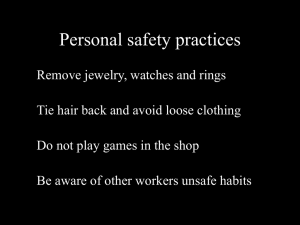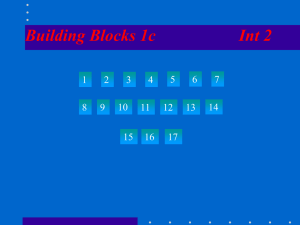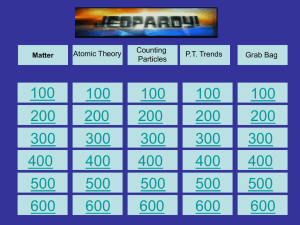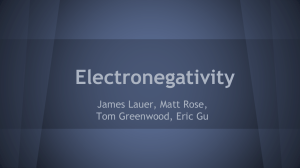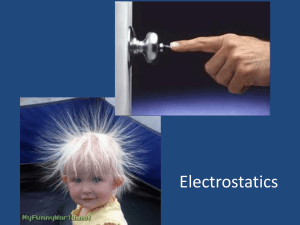Knowledge Powerpoint Pt 2
advertisement
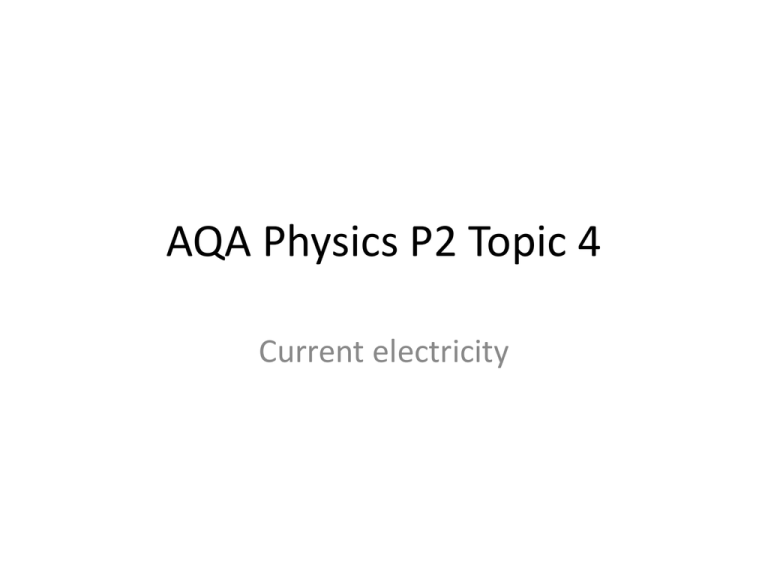
AQA Physics P2 Topic 4 Current electricity P2 4.1 Electrical charges Atoms, like the carbon atom in this diagram, are made of three different particles, the proton, the neutron and the electron. The protons and neutrons make up the nucleus of the atom. The electrons, which are much smaller (they have almost no mass), are around the outside of the atom, a very large distance (on an atomic scale) from the nucleus, so they are much less strongly bound to the atom than the two particles in the nucleus. (This is important for the explanation of ionisation below.) This table summarises the key facts. Particle In the nucleus? Charge Mass Proton Yes +1 (positive) 1 Neutron Yes 0 (no charge – neutral) 1 Electron No -1 (negative) Almost zero A normal atom has the same number of protons and electrons, so it has no overall charge – the protons’ positive charges and the electrons’ negative charges cancel out. But an atom can gain or lose electrons so it has a different number of electrons from the number of protons in the nucleus. This is called an ion and the process of gaining or losing electrons is ionisation. An ion with extra electrons is negatively charged because there are now more negative electrons than positive protons. An ion which has lost electrons is positively charged because there are less electrons. Sometimes, when two insulators are rubbed together, like a plastic rod and a cloth, some electrons can be transferred from the cloth to the rod or vice versa. If electrons are transferred from the cloth to the rod, as in this diagram, the rod becomes negatively charged because it has gained extra negative electrons. The cloth therefore becomes positively charged because it has lost negative electrons. If electrons are transferred from the rod to the cloth, the cloth becomes negatively charged and the rod becomes positively charged. It is important to remember that only the negative electrons are transferred. P2 4.1 Electrical charges (continued) You may have used a Van der Graaf generator in your school laboratory to make your hair stand on end, give electric shocks to your friends, or even light a Bunsen burner with a spark. Shocking! Or you may have held a charged rod over a goldleaf electroscope and watched the leaf rise. These things happen because like charges repel, opposite charges attract. P2 4.2 Electric circuits Electric circuits are assembled from components. Each component has an internationally-agreed symbol. A circuit diagram shows how components are connected using the standard symbols. Exam tip: you need to learn a set of symbols so that you can say what a symbol represents or sketch the symbol for a named component. Symbol sets can be found on most GCSE physics revision sites or a set of flashcards can be found at: https://www.examtime.com/en-US/p/289885 When components are connected in a complete circuit, an electric current flows. An electric current is a flow of charge. The charge is carried by a very large number (millions of millions) of electrons, each of which has a negative charge. The unit of current is the ampere (A) and the unit of charge is the coulomb (C). current = charge time I=Q t I = current in amperes (A) Q = charge in coulombs (C) t = time in seconds (s) So one ampere is one coulomb per second. P2 4.2 Electric circuits – ammeters and voltmeters Ammeters and voltmeters look very similar, which can cause confusion. But they measure different things and must be placed in different positions in the circuit. Ammeter Voltmeter Measures current potential difference (PD) Units of measurement amperes (A) volts (V) Position in circuit in series – the current flows through it in parallel – the current flows past it This diagram shows the ammeter (A) connected in series – the current flows through it. If the ammeter was removed, the circuit would be incomplete and would not work. The current is the same wherever the ammeter is placed in the circuit. But the voltmeter (V) is connected in parallel – the current flows past it, through the resistor in this case. If the voltmeter was removed, the circuit would still work. If the voltmeter was placed in a different position in the circuit, such as across the battery or fuse, the readings would be different. So what is potential difference? Although each electron moving when an electric current flows has the same charge, each charge can carry a different amount of energy. It’s rather like supermarket lorries. Although each lorry can carry the same amount of food, different foods have different amounts of energy. So the same size lorries can carry different amounts of energy. In electric circuits, the same amount of charge can carry different amounts of energy. P2 4.2/3 Electric circuits – potential difference and resistance On the last slide we said that potential difference measures how much energy a certain amount of charge carries. The unit of potential difference is the volt (V) – you will have previously called this voltage, the correct term is now potential difference. The equation to calculate potential difference is … potential difference = energy or work done charge V=W Q V = potential difference in volts (V) W = energy or work done in joules (J) Q = charge in coulombs (C) So one volt is one joule per coulomb. Resistance is a measure of how difficult it is for an electric current to pass through a component. In general, the thinner a wire is, the more difficult it is for an electric current to pass through it when given the same amount of energy (which you now know is the potential difference). But different materials produce different resistances too. So the resistance depends on the material and its size. The unit of resistance is the ohm (Ω). The equation is … resistance = potential difference current R=V I R = resistance in ohms (Ω) V = potential difference in volts (V) So one ohm is one volt per ampere. I= current in amperes (A) P2 4.3/4 Current – potential difference graphs When we experiment to measure the current that flows through different components as we change the potential difference, we find that each component produces a different shape graph that is characteristic of that component. The simplest is for a resistor with a low resistance, such as a piece of wire, which is shown by the blue line in the graph. It is a straight line that goes through the origin – when the potential difference is zero, the current is also zero. The straight line means that the current is directly proportional to the potential difference – as the potential difference is doubled, the current also doubles. This type of component obeys Ohm’s law. We say the component is ohmic. “The current through a resistor at constant temperature is directly proportional to the potential difference applied.” The red line shows the characteristic flattened S-shape for a filament lamp (an old-fashioned type of light bulb). A filament lamp does not obey Ohm’s law because the graph is not a straight line. This shape means that the resistance increases as the potential different increases. This is explained by what happens in the filament, which is a thin piece of wire. As the current flows, the wire gets hot and glows (which is why the filament bulb produces light). As the wire gets hot, the metal ions vibrate more making it more difficult for the electrons to move through the filament. So the resistance increases as the temperature rises. The bottom graph shows the shape for a diode. A diode is a component that only allows an electric current to flow in one direction. So when a potential difference is applied in the reverse direction, the current is always zero. At first, the current stays zero even when the potential difference is applied in the forward direction, but a current starts to flow once a certain potential difference has been reached. P2 4.5/6 Series and parallel circuits In a series circuit (on the left), there is only one way for the current to flow round the circuit. If one lamp breaks, neither lamp will light because there is no longer a complete circuit. In a series circuit, each lamp will be dimmer than a single lamp. In a parallel circuit (on the right), the current splits and flows two (or more) ways. If one bulb breaks, the other will still light because there is still a complete circuit. In a parallel circuit, each lamp will be as bright as a single lamp. Parallel circuits are used in homes, offices and cars so that a single failure does not cause all the lights to go out. Rules for SERIES circuits Rules for PARALLEL circuits The current in a series circuit is the same wherever you measure it. Wherever you place an ammeter, the reading will be the same. The total current in a series circuit is the sum of the currents in each branch. If you connect an ammeter before the circuit splits, the reading will equal the total of the readings taken in each branch. The total potential difference in a series circuit is the sum of the individual potential differences. If you connect a voltmeter across both lamps, the reading will equal the total of the readings taken across each lamp. Similarly, if two or more cells or batteries are connected in the same direction, the total potential difference is the sum of the individual potential difference. For example, two 1.5 batteries connected in the same direction will give a total potential difference of 3.0V. The potential difference in a parallel circuit is the same in each branch, and in each component if there is only one in each branch. If you connect a voltmeter across each lamp, the readings would be the same. Similarly, if two or more identical cells or batteries are connected in parallel in the same direction, the potential difference is the same as each cell or battery. So two 1.5 batteries in parallel would still give 1.5V. P2 4.5/6 Resistance and current 10 Ω 20 Ω 30 Ω The rule to calculate the total resistance of resistors in series is very simple. (Remember that a lamp is just a special type of resistor. Just add them together. So in this example, the total resistance is 10Ω + 20Ω + 30Ω = 60Ω. Easy. The rule for resistors in parallel is more complex – but you don’t need to know it for GCSE! Even easier!!! You can calculate the current in a series circuit, or a branch of a parallel circuit, using the equation … current = potential difference resistance I=V R I= current in amperes (A) V = potential difference in volts (V) R = resistance in ohms (Ω) AQA Physics P2 Topic 5 Mains electricity P2 5.1 Alternating current Batteries, like the ones used in torches, watches, calculators and cars, all produce direct current (DC). We say it is direct current because it flows in one direction only. When you connect to the red and black terminals on a laboratory power supply, you are using direct current. However, the mains electricity supply is alternating current (AC). We say it is alternating current because it keeps reversing its direction, flowing one way, then the opposite way, then back to the original way. In the UK, it does this 50 times per second. We say the frequency of the UK electricity supply is 50 hertz (Hz), or 50 cycles per second. An oscilloscope is a piece of laboratory equipment that allows us to visualise things that we cannot normally see, like the flow of electricity or sound waves. The horizontal axis represents time, so each square is a certain amount of time. The vertical axis, or height, represents the voltage when we are looking at electricity. This chart shows alternating current would look like on an oscilloscope. In the UK, the voltage alternates between +325 volts and -325 volts. The declared value is 230 volts, which is the direct voltage that would transfer the same power. You will find a label saying 230V on all main-powered appliances. From peak voltage to peak voltage is one complete cycle. In the UK, each cycle takes one-fiftieth of a second because there are 50 cycles per second. P2 5.2/3 Cables, plugs and fuses Mains cables have three wires. • Brown is the live wire. • Blue is the neutral wire. • Green/yellow is the earth wire. It is called the earth wire because it is literally connected to the Earth somewhere in each home, school or office using a thick metal spike driven into the ground. Cables are made of copper because copper is a very good conductor. It is also quite flexible allowing cables to bend. The copper cores of the wires are covered in a flexible plastic because plastic is a good insulator. The outside of a mains plug is also made of plastic because it is a good insulator. The pins of the plug are made of brass, an alloy containing a lot of copper, so it is a good conductor but brass is harder than copper so it does not bend as easily. The fuse is a thin piece of wire in a cardboard or plastic tube that will get hot and melt if the current is too high because there is a fault. We say the fuse has blown, but it does NOT explode! The fuse is fitted in the live wire. A Resisidual Current Circuit Breaker (RCCB) is faster and more sensitive than a fuse. It breaks the circuit when the current in the live and neutral wires are not the same. Life tip: it is important for your own and other people’s safety that you know how to wire a mains plug correctly. If in doubt, check before you start. The earth wire prevents the metal case of an appliance like a microwave from becoming ‘live’. If you touched a ‘live’ metal case you would be electrocuted. Some appliances which have metal cases do not need an earth wire. We say they are double insulated and they have this symbol. P2 5.4 Electrical power and potential difference The general equation for power, which you learned in Core Science P1, is … power = energy transferred time P=E t P = power in watts (W) E = energy transferred in joules (J) One watt is therefore equal to one joule per second t = time in seconds (s) 1W = 1J/s Electrical power can also be calculated using this equation … power = current x potential difference P=IxV P = power in watts (W) I = current in amperes (A) V = potential difference in volts (V) Fuses come with standard ratings like 3A, 5A and 13A. To work out which fuse rating you need for an appliance, calculate the current using … I=P V … then fit the next higher rating. So, for a 1000W heater, I = 1000 ÷ 230 = 4.35A. You need a 5A fuse. P2 5.5 Electrical energy and charge You know that electrons have a negative charge. When an electric current flows, a large number of electrons move through the wires. An electric current is a flow of charge. The unit of charge is the coulomb (C). The amount of charge is calculated using this equation … charge = current x time Q=Ixt Q = charge in coulombs (C) I = current in amperes (A) t = time in seconds (s) When an electric current flows, charge passing through a resistor (a thin wire or other material) transfers energy to it, making it hot. This is why a light bulb glows or a fuse blows, when the current is too high so too much energy is transferred. The amount of energy transferred is calculated using this equation … energy transferred = potential difference x charge E=VxQ E= energy transferred in joules (J) V = potential difference in volts (V) Q = charge in coulombs (C) Exam tip: the symbols for units that are named after scientists, such as newtons, joules, watts, amperes, volts and coulombs are all CAPITAL LETTERS. If you write these symbols in lower case in an answer, you will lose the mark. P2 5.6 Electrical issues A filament bulb is very inefficient. A typical filament bulb has an efficiency of about 20%. That means out of every 100 joules of energy input to it, only 20 joules are transferred as light, which is the useful energy. The other 80 joules are transferred as heat, which is wasted. Filament bulbs don’t last very long but they are inexpensive, although it may cost more to replace a filament bulb several times than to buy one of the alternatives that last longer. A halogen bulb is slightly more efficient, so more of each 100 joules input to it are transferred as useful light energy and less are transferred as wasted heat energy. They last several times longer than filament bulbs, but they also cost several times more than filament bulbs. A compact fluorescent bulb (CFL) is much more efficient than a filament or halogen bulb – about 3 to 4 times. Compact fluorescent bulbs require much less input energy to produce the same amount of light as filament or halogen bulbs. Even though they cost several times more than filament bulbs, they last many times longer than both filament bulbs and halogen bulbs so, in the long term, using compact fluorescent bulbs saves money on both electricity and the cost of replacement bulbs, even though the bulb costs more to buy in the first place. Many filament bulbs in homes have now been replaced by compact fluorescent bulbs. A light-emitting diode (LED) bulb contains many small LEDs, each of which produces only a small amount of light but, because there are many of them, the bulb produces about the same amount of light as the other types. Because LEDs are extremely efficient, producing very little wasted heat energy, they require even less input energy to produce the same amount of light. They last even longer than compact fluorescent bulbs but are the most expensive. AQA Physics P2 Topic 6 Radioactivity P2 6.1 Observing nuclear radiation Radioactivity was discovered by accident by Henri Becquerel. An image of a key appeared on a photographic film when the key was left between the film and a packet of uranium salts. Becquerel concluded that something must have passed from the uranium salts through the paper that the film was wrapped in, but that it must have been blocked by the metal keys. Becquerel asked his young research assistant, Marie Curie, to investigate. It was she who coined the word radioactivity. Radioactive emissions happen when some nuclei of an element are unstable. The nuclei become stable by emitting radiation. There are three types of radiation: alpha, beta and gamma. Alpha and beta are particles. Gamma is a form of energy. Background radiation is everywhere all the time. Most of it comes from natural sources, including radon gas in the air (50%), radioactive rocks in the ground (14%) and cosmic rays (10%). 12% is in our food! Only about 13% comes from manmade sources, mostly medical, including Xrays. Less than 1% comes from nuclear power and fallout from nuclear explosions and accidents. P2 6.2 The discovery of the nucleus Until 1911, the accepted model of the atom was known as the plum pudding model (top diagram). It was believed that the atom was a ball of positive charge with negatively-charged electrons (discovered in 1897) buried inside. Then Ernest Rutherford, together with his research assistants Ernest Marsden and Hans Geiger (after whom the Geiger counter detector is named) conducted an experiment. They fired alpha particles at a thin sheet of metal foil. They expected the alpha particles to pass straight through, as shown by the arrows on the top diagram. To their surprise, some of the alpha particles changed direction and some even bounced back! Rutherford was so astonished he likened it to firing artillery shells at tissue paper and having them rebound! Their results could not be explained by the plum pudding model. Rutherford deduced that there was a positively-charged nucleus at the centre of the atom. The nucleus must be positively-charged because it repelled positively-charged alpha particles. (Remember, like charges repel.) And the nucleus must be much smaller than the atom because most alpha particles passed straight through (as shown on the middle diagram. Consequently, most of the atom is empty space. Rutherford’s nuclear model of the atom was improved with discovery of the neutron in 1932. This story demonstrates how new evidence can cause an accepted theory to be re-evaluated if experimental evidence does not fit. Did you know? The nucleus is 100,000 times smaller than the whole atom. If the nucleus was 1cm across, the electrons would be 1km away. The rest is empty space. P2 6.3 Nuclear reactions Isotopes are atoms of an element with the same number of protons and electrons but with different numbers of neutrons. To describe isotopes, we use an expanded version of the familiar chemical element symbols. Maths tip: to work out the number of neutrons in an isotope, take away the atomic number from the mass number This is the mass number. It is the total number of protons and neutrons. Isotopes have different mass numbers but the same atomic number. This is the chemical symbol from the periodic table. This is the atomic number (or proton number). It is the number of protons in the nucleus. All atoms of an element have the same number of protons. Subatomic particle Relative mass Relative charge proton 1 +1 neutron 1 0 electron almost zero -1 The sub-atomic particles Fact: the number of electrons in an atom equals the number of electrons in the nucleus Alpha () radiation Beta () radiation Gamma () radiation Particle emitted 2 protons and 2 neutrons a fast-moving electron not a particle Change to mass number -4 no change no change Change to proton number -2 +1 (a neutron changes into a proton) no change Radiation facts P2 6.4 Alpha, beta and gamma radiation An ion is an atom with an electrical charge, either because it has lost or gained one or more electrons. The three types of ionising radiation can all ionise atoms to different degrees by knocking an electron off the atom. Type of radiation (symbol) What is it? Alpha (α) particle 2 protons, 2 neutrons (a helium nucleus) Beta (β) particle A fastmoving electron Gamma (γ) wave An electromagnetic wave Charge Ionising power Penetrating power Range in air Affected by electric fields? Affected by magnetic fields? +2 Strong Weak – stopped by a thin sheet of paper ~ 5 cm Yes (because it has a positive charge, it is repelled from the positive plate) Yes -1 Weak Average – stopped by 5mm of aluminium ~1m Yes (because it has a negative charge, it is attracted to the positive plate) Yes None (because it’s a wave) Very weak Strong – requires several cm of lead sheet unlimited No (because it’s an electromagnetic wave) No Ionising radiation facts Did you know? X-rays can also cause ionisation. This is why X-ray operators have to take precautions to avoid over-exposure to X-rays. Ionisation in a living cell can damage or kill the cell. If the cell’s DNA is damaged, the damage can be passed to new cells, which can cause cancer. P2 6.5 Half-life The half-life of a radioactive substance is the time it takes for half the number of radioactive nuclei to decay. In this graph, the half-life is 400 seconds. After one half-life (400 s), half of the radioactive nuclei have decayed so half remain. During the second half-life (another 400s), half of the remaining nuclei decay. So after two half-lives (800s), three quarters of the original nuclei have decause and one quarter of the original nuclei remain. After three half-lives (another 400s, so 1200s total), 7/8ths of the original nuclei have decayed, so just 1/8th remain. Radioactive decay is random. We cannot predict when a single atom will decay but we can predict what proportion of the original number will decay in a given time, or how long it will take for the number to halve – the half-life. The activity of a radioactive source is the number of atoms that decay per second. Radioactivity is measured using a Geiger counter, which clicks as it is affected by radiation. The greater the activity, the more clicks the Geiger counter makes. The more half-lives there have been, the lower the activity. To find the half-life from a graph, follow these steps: 1. Look at the initial count on the y-axis (80). 2. Halve it (40) and mark it on the y-axis 3. Draw a line straight across from the y-axis to the plot. 4. Draw a second line from where the first line intercepted the plot straight down to the x-axis. 5. The half-life is where the second line meets the x-axis. Did you know? Half-lives vary from seconds to billions of years. The length of the half-life is important when choosing an isotope for a particular use. P2 6.6 Radioactivity at work Radioactivity is used for many different purposes. These are a few uses that you need to know about. Automatic thickness monitoring is used to make metal foil. If too much radiation is detected, the foil is too thin. If too little radiation is detected, the foil is too thick. The rollers are then adjusted by computer. Carbon dating can be used to determine the age ancient living things using carbon 14, which has a half-life of 5640 years. Medical tracers are shorthalf-life gamma sources such as an isotope of iodine (I-131) that are used to visualise what is happening inside the body without surgery. Reading from a detector are sent to a computer which produces images of the organs inside the body. Uranium dating is used to date rocks. Two isotopes of uranium have half-lives of about 700 million years (U-235) and 4.5 billion years (U-238). They can therefore be used to date rocks on Earth, which is about 4.3 billion years old. Smoke detectors use alpha radiation to ionise the air in a chamber so that an electric current passes. When smoke enters the ionisation chamber, the current reduces, which is detected and the alarm sounds. AQA Physics P2 Topic 7 Energy from the nucleus P2 7.1 Nuclear fission During nuclear fission, atomic nuclei split. This releases energy. In a nuclear power station, the energy heats water and turns it into steam. The steam turns a turbine, which turns a generator, which generates electricity. The two fissionable elements commonly used in nuclear reactors are uranium-235 (U235) and plutonium-239 (Pu239). Most nuclear reactors use uranium-235. The top diagram shows what happens during nuclear fission of uranium235. Fission occurs when a neutron hits a uranium nucleus. The nucleus splits into smaller nuclei (so they are different elements) and more neutrons. The neutrons hit more uranium nuclei causing them to split, producing smaller nuclei and more neutrons. Thus the reaction continues, getting bigger and bigger. This is called a chain reaction. Exam tip: you need to be able to sketch or complete a labelled diagram to illustrate how a chain reaction occurs, so remember this diagram. The bottom diagram shows a nuclear reactor which uses gas to take heat energy from the reactor vessel to a heat exchanger where it turns water into steam. Other reactors designs use pressurised water instead of gas. The purpose of the moderator is to slow down the neutrons, which is necessary because fast neutrons do not cause further fission. The control rods absorb neutrons so that, on average, only one neutron per fission reaction goes on to produce further fission, preventing a chain reaction. Fact: nuclear fission is not the same as radioactive decay. Nuclear fission is caused by a man-made process (bombardment with neutrons). Radioactive decay is a spontaneous process when isotopes are unstable. P2 7.2 Nuclear fusion During nuclear fusion, two atomic nuclei join together to form a larger one. Energy is released when to light nuclei fuse together. Nuclear fusion is the process by which energy is released in stars. The top diagram shows what happens in stars like the Sun. The Sun is about 75% hydrogen. Deuterium and tritium are isotopes of hydrogen with additional neutrons. Most hydrogen nuclei consist of only one proton with no neutrons, but because the Sun is so hot, there are lots of these ‘heavy’ hydrogen isotopes. When they collide, they fuse to produce helium, which makes up the other 25% of the Sun. Fusion reactors could meet all our energy needs, but there are enormous practical difficulties. As shown in the bottom diagram, a fusion reactor needs to be at an extremely high temperature before nuclear fusion can occur, and the plasma needs to be contained by a powerful magnetic field. Did you know? In March 2014, 13 year-old Jamie Edwards from Preston in Lancashire became the youngest person ever to carry out atomic fusion. He built a fusion reactor in school, smashing two hydrogen atoms together to make helium. This is not yet a standard school practical! P2 7.3 Radioactivity all around us Keywords • Background radiation – ionising radiation that is around us all the time from a number of sources. Some is naturally occurring. • Background count – the average number of counts recorded by a GM tube in a certain time from background radiation • Radon gas – naturally occurring radioactive gas that is emitted from rocks as a result of the decay of radioactive uranium • • • We are constantly exposed to ionising radiation – from space and naturally occurring = background radiation Needs to be considered when measuring a source Background count is subtracted from the source count Background Radiation • Main source = radon gas • Released from decaying uranium in rocks • Diffuses into the air from rocks and soil • Medical sources = x-rays; gamma rays (scans) and cancer treatments • Some food are naturally radioactive • Cosmic rays = high energy charged particles from the stars (like the Sun) and supernovae, neutron stars and black holes. • Many cosmic rays are stopped by the atmosphere but some reach Earth. P2 7.4 The early universe The Big Bang that created the Universe was about 13 billion years ago. The first galaxies and stars formed a few billion years later. Before the galaxies and stars formed, the universe was a dark, patchy cloud of hydrogen and helium, which are the two most abundant elements in the Universe. The first galaxies and stars formed after a few billion years The force of gravity pulled dust and gas into stars and galaxies. A galaxy is a collection of billions of stars held together by the force of their own gravity. Smaller masses may also form and be attracted by a larger mass to become planets. Did you know? The early Universe contained only hydrogen. All the other elements were formed in stars. We and everything around us are made from the remains of stars! Quarks and electrons formed from pure energy in a tenth of a second Protons and neutrons formed in less than two minutes Hydrogen and helium atoms formed after 100 000 years The first galaxies and stars formed after a few billion years P2 7.5 The life history of a star Stars go through a lifecycle. There are two paths through the lifecycle. Which path a star takes depends on its size. Quarks and electrons formed from pure energy in a tenth of a second Protons and neutrons formed in less than two minutes 1. All stars start as a protostar, a cloud of dust and gas drawn together by gravity in which fusion has not yet started. 2. As a protostar gets bigger, gravity makes it get denser and hotter. If it becomes hot enough, fusion starts. This is called a main sequence star because this is the main stage in the lifecycle of a star. A star can stay in this stage for billions of years. During this stage, the forces in it are balanced: the inward force of gravity is balanced by the outward force of the radiation from the core. What happens next depends on the size of the star. Hydrogen and helium atoms formed after 100 000 years The first galaxies and stars formed after a few billion years 3a. Low mass stars (like the Sun) expand, cool down and turn red. The star is now a red giant. Helium and other light elements in the core fuse to form heavier elements up to iron. 3b. Stars much bigger than the Sun expand even more to become a red supergiant. This collapses, compressing the core more and more until there is a massive explosion called a supernova. When there are no more light elements left in the core, fusion stops. Due to gravity, it collapses and heats up becoming a white dwarf. As it cools, it becomes a black dwarf. The explosion compresses the remaining core of the star into a neutron star or, if it is really big, a black hole. The gravity of a black hole is so strong that not even light can escape. P2 7.5 The life history of a star (continued) Exam tip: you need to be able to sketch or complete a labelled diagram to illustrate the lifecycle of a star, so remember this diagram, the reason why a star goes ‘left’ or ‘right’ (its size/mass) and what happens at each stage. P2 7.6 How the chemical elements formed Main sequence stars fuse hydrogen nuclei into helium and other small nuclei, including carbon. When stars like the Sun become red giants, they fuse helium and other light elements to form heavier elements up to iron. But nuclei larger than iron cannot be formed this way because too much energy is needed. All the elements heavier than iron were formed when red supergiants collapsed then exploded in a supernova. The enormous force fuses small nuclei into the larger nuclei of heavier elements. The debris from a supernova contains all the elements. Planets form from that debris. Hence the Sun and the rest of the Solar System were formed from the debris of a supernova. Remember: • Elements up to iron were formed in stars by nuclear fusion • Elements heavier than iron were formed in supernova explosions



